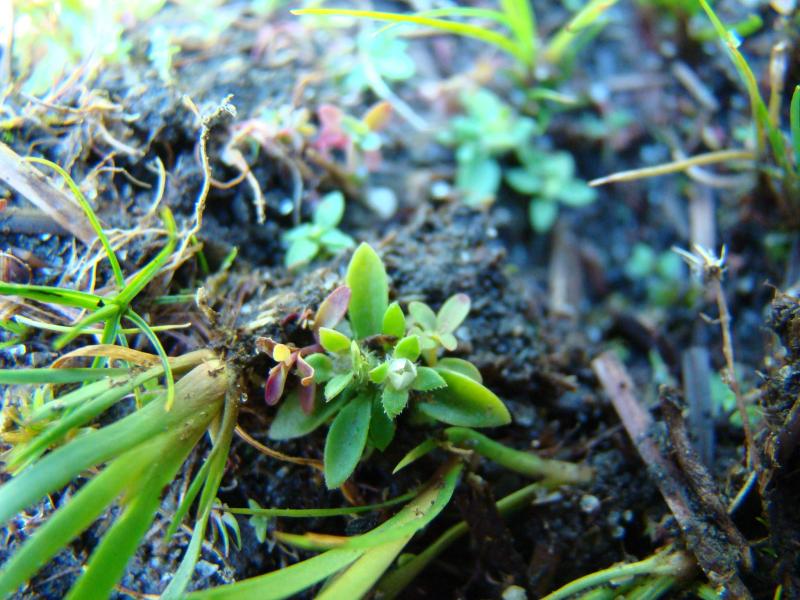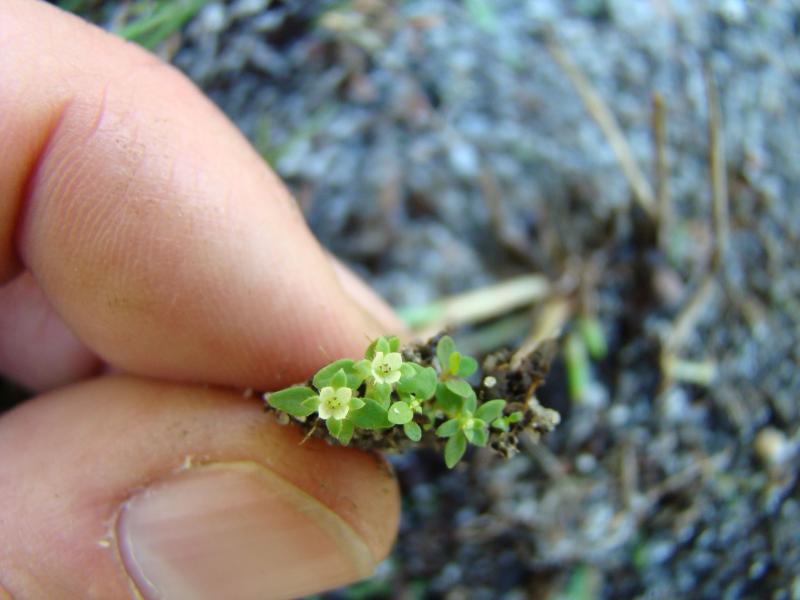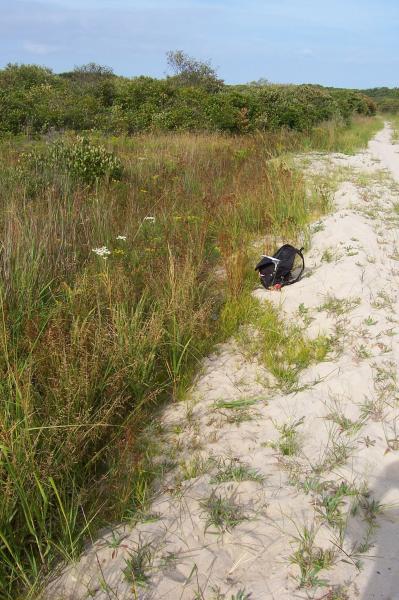Clustered Bluets
Edrastima uniflora (Linnaeus) Rafinesque
- Class
- Dicotyledoneae (Dicots)
- Family
- Rubiaceae (Madder Family)
- State Protection
- Endangered
Listed as Endangered by New York State: in imminent danger of extirpation in New York. For animals, taking, importation, transportation, or possession is prohibited, except under license or permit. For plants, removal or damage without the consent of the landowner is prohibited.
- Federal Protection
- Not Listed
- State Conservation Status Rank
- S1
Critically Imperiled in New York - Especially vulnerable to disappearing from New York due to extreme rarity or other factors; typically 5 or fewer populations or locations in New York, very few individuals, very restricted range, very few remaining acres (or miles of stream), and/or very steep declines.
- Global Conservation Status Rank
- G5
Secure globally - Common in the world; widespread and abundant (but may be rare in some parts of its range).
Summary
Did you know?
The genus Edrastima is a relatively new change in the genus name. In the past the plant was placed in the genus Oldenlandia and Hedyotis.
State Ranking Justification
There are nine existing populations but only three of them have over 200 plants. There are three historical populations from the early 1900s that have not been resurveyed.
Short-term Trends
The short-term trend appears to be stable to someone increasing. Most of the populations were resurveyed in the mid-2000s. All of them were doing about the same or had increased in number. Exact trends cannot be understood unless surveys are done every year because of the fluctuating nature of this pondshore species.
Long-term Trends
This plant has always been rare in New York. However, it's long-term trend appears stable with about the same number of populations for the last 100 years.
Conservation and Management
Threats
Some ponds have seen too much development along the shoreline which threaten populations with direct disturbance by trampling and ATV use. The invasion of Phragmites is also a threat to a few populations.
Conservation Strategies and Management Practices
The pondshores need to be protected from direct disturbance by ATVs and excessive trampling. Exotic invasive species must be prevented from colonizing the shores and present populations must be eliminated. A natural buffer of at least 200 feet should be established around the ponds to prevent excessive runoff and pollution events.
Research Needs
Research into the fluctuating water levels and habitat requirements of this plant is needed to better understand the optimum conditions for its growth.
Habitat
Habitat
In New York almost all of the plants grow on coastal plain pondshores among other species of wildflowers. The ponds can be surrounded by pitch pine forest or oak woods. One population was found in wet spots of oak woods along a sandy road down that leads down to a saltmarsh (New York Natural Heritage Program 2012).
Associated Ecological Communities
- Coastal plain pond shore
(guide)
The gently sloping shore of a coastal plain pond with seasonally and annually fluctuating water levels. Plants growing on the pond shore vary with water levels. In dry years when water levels are low there is often a dense growth of annual sedges, grasses, and herbs. Submerged and floating-leaved aquatic plants, such as fragrant waterlily and pondweeds, may become "stranded" on the exposed shore. In wet years when the water level is high only a few emergents and floating-leaved aquatics may be noticeable. T
Associated Species
- Bidens cernua (nodding beggar-ticks)
- Cyperus dentatus (toothed flat sedge)
- Drosera intermedia (spatulate-leaved sundew)
- Eleocharis flavescens var. olivacea (olive-fruited spike-rush)
- Euthamia caroliniana (slender flat-topped-goldenrod)
- Fimbristylis autumnalis (autumn fimbry)
- Gratiola aurea (golden hedge-hyssop)
- Hypericum canadense (lesser Canadian St. John's-wort)
- Juncus canadensis (Canada rush)
- Lipocarpha micrantha
- Ludwigia alternifolia (alternate-leaved seed-box)
- Panicum
- Panicum virgatum (switch grass)
- Rhynchospora capitellata (brownish beak sedge)
- Rhynchospora nitens (short-beaked beak sedge)
- Rhynchospora scirpoides (long-beaked beak sedge)
- Toxicodendron radicans
- Viola lanceolata (lance-leaved violet)
Range
New York State Distribution
It is currently known only from Suffolk County, Long Island, but there are historical records and unconfirmed reports west through New York City and Westchester County.
Global Distribution
It is most common on or near the coastal plain from Long Island south to Florida and west to eastern Texas. There are some scattered inland populations in Tennessee, Kentucky, Missouri, and Arkansas.
Identification Comments
General Description
Clustered bluets is a small, erect or spreading annual 1-5 dm tall. The hairy stem can be simple or sometimes many-branched. The opposite, lanceolate to oval leaves are sessile on the stem and 1-2.5 cm long. They have an obvious midvein and are white-hairy on the margins and the midvein. The flowers are in clusters along the stem or at the top and have four small white petals that are shorter than the sepals and lack a funnel-shaped base. The fruit is a rounded, white-hairy capsule that is also shorter than the sepals (Gleason and Cronquist 1991).
Identifying Characteristics
Distinguishing characteristics: annual; leaves lanceolate to oval; corolla white, 2 mm wide; capsule white- hairy; seeds very numerous. Best life stage for ID: in flower. Characteristics needed to ID: flowers and leaves.
Best Life Stage for Proper Identification
This species is best identified with the leafy plant in flower or fruit.
Similar Species
Other bluet species have flowers that are more funnel-shaped below and are more bluish or purple. They also occur in drier soils (Gleason and Cronquist 1991).
Best Time to See
Flowers August through September with fruits persisting through October.
- Flowering
- Fruiting
The time of year you would expect to find Clustered Bluets flowering and fruiting in New York.
Clustered Bluets Images
Taxonomy
Clustered Bluets
Edrastima uniflora (Linnaeus) Rafinesque
- Kingdom Plantae
- Phylum Anthophyta
- Class Dicotyledoneae
(Dicots)
- Order Rubiales
- Family Rubiaceae (Madder Family)
- Order Rubiales
- Class Dicotyledoneae
(Dicots)
- Phylum Anthophyta
Synonyms
- Hedyotis uniflora (L.) Lam.
- Oldenlandia uniflora L.
Additional Resources
Best Identification Reference
Gleason, Henry A. and A. Cronquist. 1991. Manual of Vascular Plants of Northeastern United States and Adjacent Canada. The New York Botanical Garden, Bronx, New York. 910 pp.
Other References
Clemants, Steven and Carol Gracie. 2006. Wildflowers in the Field and Forest. A Field Guide to the Northeastern United States. Oxford University Press, New York, NY. 445 pp.
Fernald, M.L. 1950. Gray's manual of botany. 8th edition. D. Van Nostrand, New York. 1632 pp.
Holmgren, Noel. 1998. The Illustrated Companion to Gleason and Cronquist's Manual. Illustrations of the Vascular Plants of Northeastern United States and Adjacent Canada. The New York Botanical Garden, Bronx, New York.
New York Natural Heritage Program. 2010. Biotics database. New York Natural Heritage Program. New York State Department of Environmental Conservation. Albany, NY.
New York Natural Heritage Program. 2024. New York Natural Heritage Program Databases. Albany, NY.
Weldy, T. and D. Werier. 2010. New York flora atlas. [S.M. Landry, K.N. Campbell, and L.D. Mabe (original application development), Florida Center for Community Design and Research http://www.fccdr.usf.edu/. University of South Florida http://www.usf.edu/]. New York Flora Association http://newyork.plantatlas.usf.edu/, Albany, New York
Links
About This Guide
This guide was authored by: Stephen M. Young
Information for this guide was last updated on: September 16, 2021
Please cite this page as:
New York Natural Heritage Program. 2024.
Online Conservation Guide for
Edrastima uniflora.
Available from: https://guides.nynhp.org/clustered-bluets/.
Accessed July 26, 2024.


